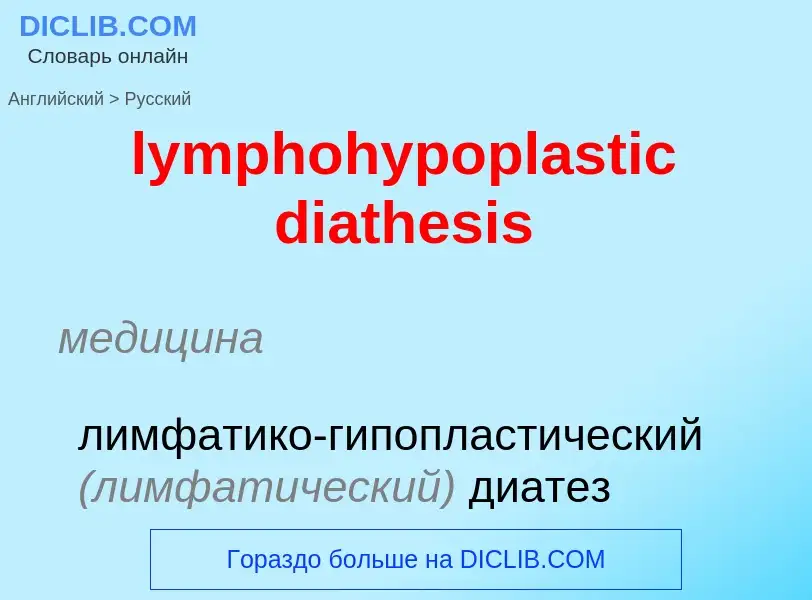Translation and analysis of words by ChatGPT artificial intelligence
On this page you can get a detailed analysis of a word or phrase, produced by the best artificial intelligence technology to date:
- how the word is used
- frequency of use
- it is used more often in oral or written speech
- word translation options
- usage examples (several phrases with translation)
- etymology
lymphohypoplastic diathesis - translation to russian
медицина
лимфатико-гипопластический (лимфатический) диатез
[dai'æθisis]
медицина
диатез
существительное
медицина
диатез
Definition
Wikipedia
The diathesis-stress model, also known as the vulnerability–stress model, is a psychological theory that attempts to explain a disorder, or its trajectory, as the result of an interaction between a predispositional vulnerability, the diathesis, and stress caused by life experiences. The term diathesis derives from the Greek term (διάθεσις) for a predisposition or sensibility. A diathesis can take the form of genetic, psychological, biological, or situational factors. A large range of differences exists among individuals' vulnerabilities to the development of a disorder.
The diathesis, or predisposition, interacts with the individual's subsequent stress response. Stress is a life event or series of events that disrupt a person's psychological equilibrium and may catalyze the development of a disorder. Thus the diathesis-stress model serves to explore how biological or genetic traits (diatheses) interact with environmental influences (stressors) to produce disorders such as depression, anxiety, or schizophrenia. The diathesis-stress model asserts that if the combination of the predisposition and the stress exceeds a threshold, the person will develop a disorder. The use of the term diathesis in medicine and in the specialty of psychiatry dates back to the 1800s. However, the diathesis-stress model was not introduced and used to describe the development of psychopathology until it was applied to explaining schizophrenia in the 1960s by Paul Meehl.
The diathesis-stress model is used in many fields of psychology, specifically for studying the development of psychopathology. It is useful for the purposes of understanding the interplay of nature and nurture in the susceptibility to psychological disorders throughout the lifespan. Diathesis-stress models can also assist in determining who will develop a disorder and who will not. For example, in the context of depression, the diathesis-stress model can help explain why Person A may become depressed while Person B does not, even when exposed to the same stressors. More recently, the diathesis-stress model has been used to explain why some individuals are more at risk for developing a disorder than others. For example, children who have a family history of depression are generally more vulnerable to developing a depressive disorder themselves. A child who has a family history of depression and who has been exposed to a particular stressor, such as exclusion or rejection by their peers, would be more likely to develop depression than a child with a family history of depression that has an otherwise positive social network of peers. The diathesis-stress model has also served as useful in explaining other poor (but non-clinical) developmental outcomes.
Protective factors, such as positive social networks or high self-esteem, can counteract the effects of stressors and prevent or curb the effects of the disorder. Many psychological disorders have a window of vulnerability, during which time an individual is more likely to develop a disorder than others. Diathesis–stress models are often conceptualized as multi-causal developmental models, which propose that multiple risk factors over the course of development interact with stressors and protective factors contributing to normal development or psychopathology. The differential susceptibility hypothesis is a recent theory that has stemmed from the diathesis–stress model.

